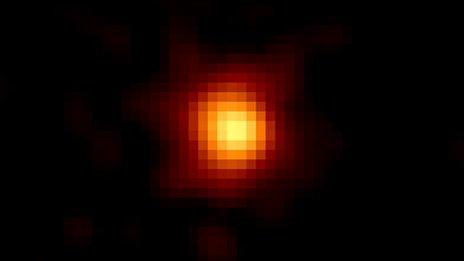Radio flash tracked to faraway galaxy
- Published

The host galaxy is at the centre of this false-colour, negative image from the Subaru telescope
For the first time, scientists have tracked the source of a "fast radio burst" - a fleeting explosion of radio waves which, in this case, came from a galaxy six billion light-years away.
The cause of the big flash, only the seventeenth ever detected, remains a puzzle, but spotting a host galaxy is a key moment in the study of such bursts.
It also allowed the team to measure how much matter got in the way of the waves and thus to "weigh the Universe".
Their findings are published in Nature, external.
Wake-up call
Fast radio bursts last only milliseconds but in that moment, whatever makes them blasts as much energy into space - in the form of radio waves - as our Sun emits in days or even weeks.
To follow this particular signal home, an international team did rapid detective work with multiple telescopes and ultimately snapped an image of the source galaxy in visible light.
Lead author Evan Keane had set up an alert system to trigger this flurry of activity, by running live data from the Parkes Radio Telescope in Australia directly into a supercomputer.
"The goal was to reduce the lag from the thing hitting the dish, to us knowing that it hit the dish, from months - to nothing," he told the BBC.
Sure enough, when one of these mysterious bursts hit Parkes' famous 64m dish on April 18 2015, alarm bells rang and emails quickly circled the planet.
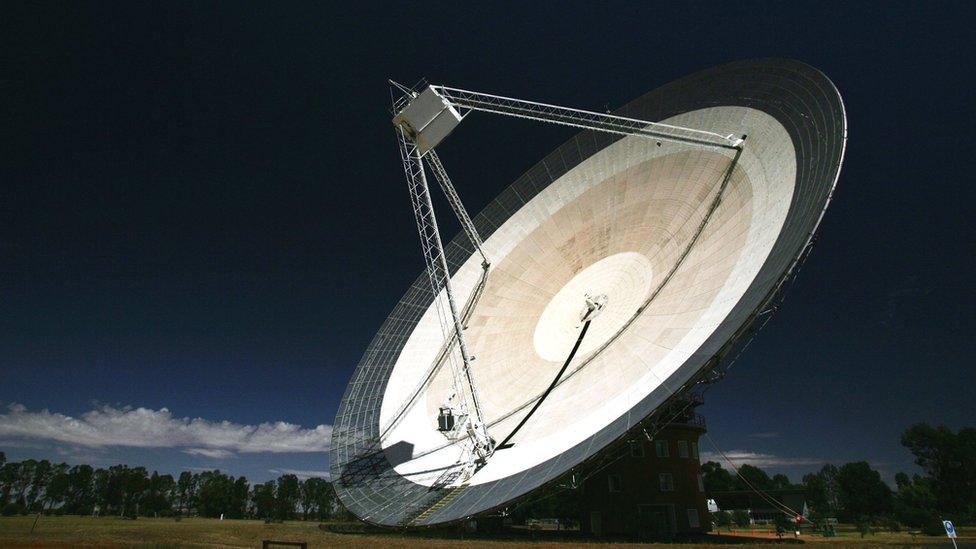
Fast radio bursts were first discovered a decade ago by the Parkes Radio Telescope
By way of contrast, the first fast radio burst (FRB) ever detected struck the same dish in 2001 but was only reported in 2007, external.
"A decade ago, we weren't really looking for them - and also our ability to handle the data and to search it in a reasonable time was significantly poorer," said Dr Keane, who now works for the Square Kilometre Array Organisation in Jodrell Bank, UK.
"Whereas with this one, I was awoken by my phone going crazy a few seconds after it happened, saying: Evan, wake up! There was an FRB!"
Two hours later, the six 22m dishes of the Australian Telescope Compact Array, a 400km drive from Parkes, were already homing in on the culpable corner of the sky.
They caught an afterglow of the flash, which took six days to fade. It was much fainter than the burst itself but allowed the team to zoom in on the source of the burst with 1,000 times more precision than ever before.
Knowing exactly where to look, they next went hunting in optical light using the Subaru Telescope in Hawaii, run by the National Astronomical Observatory of Japan.

The radio signal (black-and-white inset) arrives at different times in different wavelengths
"Right where the Compact Array tells us there should be something, there is a galaxy," Dr Keane said.
Close examination of the Subaru data showed the galaxy to be elliptical - an off-spherical blob of stars that is well past its prime, in galactic terms.
Cosmic weigh-in
"This is not what we expected," said co-author Dr Simon Johnston, the head of astrophysics at CSIRO which runs the Australian telescopes.
If the host galaxy is old, then the flash was more likely caused by a merger of dead stars than, for example, a supernova blowing up.
"It might mean that the FRB results from, say, two neutron stars colliding rather than anything to do with recent star birth.
"Our discovery opens the way to working out what makes these bursts."

Unlikeliness of aliens
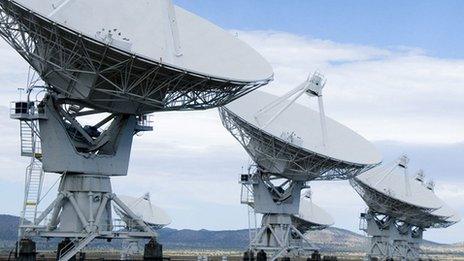
Despite occasional speculation, astronomers are confident that fast radio bursts come from extreme stellar events and not alien civilisations
But radio telescopes have been scanning the skies for decades and some of their discoveries have been very difficult to explain

Crucially, having an optical snap of the galaxy lets astronomers calculate how far away it is, based on its redshift - the stretching of light by the expansion of the Universe.
And with that distance chalked up, the team could do some cosmology.
Within an FRB, Dr Keane explained, the short wavelengths arrive before the longer ones.
"This is because the signal crashes into the particles and dust in between... and they cause a tiny delay. But if you travel six billion light-years, the delay accumulates.
"From that we can say ok, if it got a second's worth of delay on its journey, that means it passed through this many particles."
So he and his team, for the first time, used a far-flung radio signal to calculate the density of the intervening swathe of cosmos.

The high resolution of CSIRO's compact array helped zoom in on the source of the blast
"It's essentially weighing the Universe."
Their cosmic weigh-in had a happy result for our current model. It matches the quantity of stuff we expect from the 5% of the Universe that should, in fact, be matter.
The other 95% (25% dark matter and 70% dark energy - we think) is famously mysterious. But in fact, only half of the matter that ought to be in the knowable 5% has ever been detected using telescopes.
The remainder has been referred to as "missing".
"All of the matter causes a delay in the FRB signal - both the half that we had seen, and the half we hadn't," said Dr Keane.
"So we measured this delay, and if you work out how much matter must be there to cause it - it's right. The missing matter is missing no more."
Follow Jonathan on Twitter, external
- Published5 May 2015
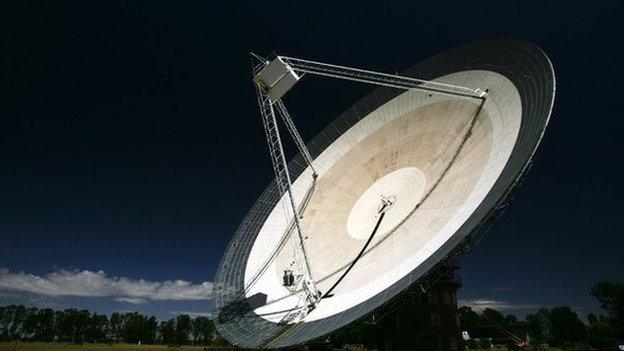
- Published3 April 2015
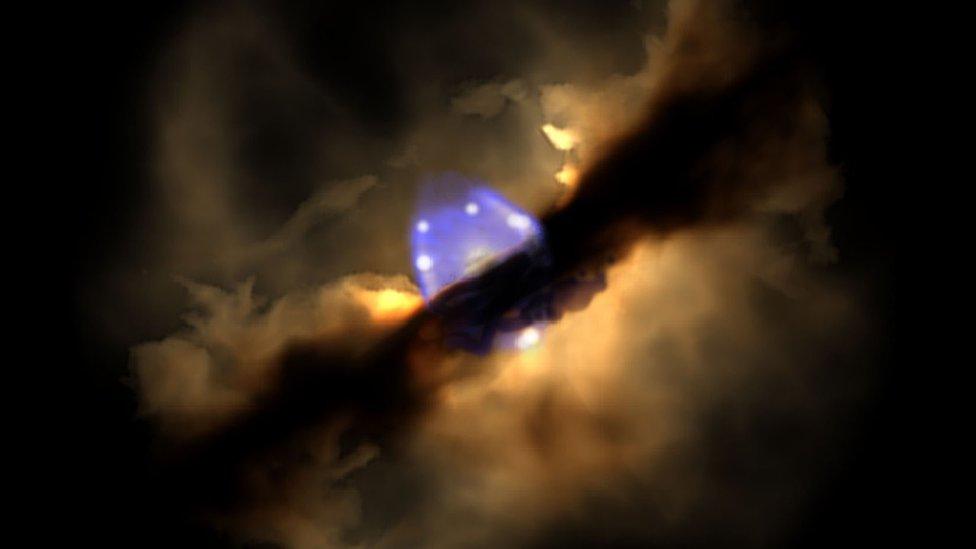
- Published21 November 2013

- Published16 April 2013
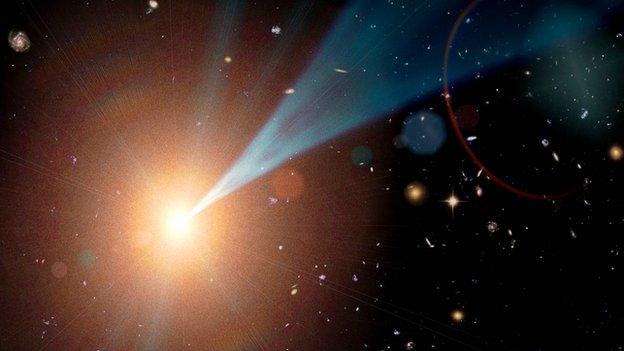
- Published25 May 2011
